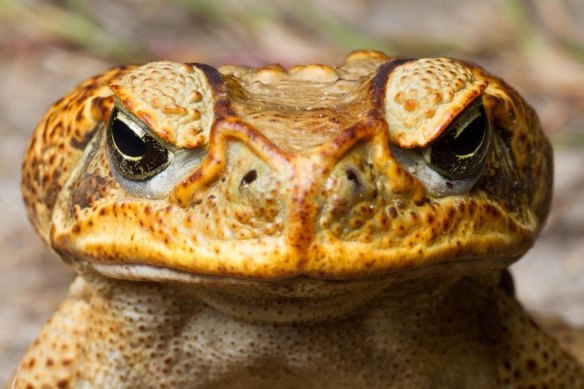This was published 3 years ago
Sydney council hunts for cane toad on the loose
By Laura Chung
They are reviled by most, feared by many and are a source of fascination for some. Now, one of Australia’s infamous cane toads has been spotted in Sydney’s west, with the City of Canterbury Bankstown council warning residents to be alert for further sightings.
A council spokesperson said the toad had been spotted at WH Wagener Oval in Ashbury on April 19 and their teams would now search for it and make sure it was the only one.

The invasive cane toad. Credit: Steven Zozaya / Invasive Animals Cooperative Research Centre
“We believe there have been sightings in other areas of NSW due to the recent, extreme weather conditions,” the spokesperson said. “While there is no broadscale method to control the cane toad, it’s important we maintain awareness by reporting any sightings.”
The pests are not the only animals that have likely been displaced due to extreme weather: bush rats, funnel webs, bats, mosquitoes, owls and turtles are other creatures that have been spotted in unusual places.
The pests are thought to have arrived in NSW from Queensland through freight, green waste or hitchhiking on loads of timber. In recent years there have been several sightings of the poisonous amphibians, including in Sydney, the North Coast, South Coast and the north-west regions.
The rotund toads are indigenous to South and Central America. In 1935, Australian cane farmers initially imported 102 marine toads to contain beetles attacking their sugar cane crops. Decades later, the population is up to as many as an estimated 1.5 billion toads spread across the continent. They are considered pests because of the damage they can cause to the environment, animals and industry.
Research last year found South American tadpoles lived peacefully with each other, while tadpoles from across Australia try to eat each other. Scientists believe this is because there was more competition for limited resources in the more challenging Australian environment, and this led the Australian tadpoles to try to kill off their competition.
Meanwhile, cane toads living on the fringes of their geographical territory (such as in NSW) have been found to have smaller testes than those that live in the core population areas. Why? Their ancestors were too busy exploring to have much sex.
The NSW Department of Primary Industries has asked anyone who has seen a cane toad, or what they believe may be one, to report it immediately on 1800 680 244, and, if safe to do so, remove it from the area and contain it.
“While doing so, people should be cautious as cane toads can ooze and sometimes squirt poison from glands behind their heads when stressed. To help avoid any potential exposure to a cane toad’s poison, people should wear protective clothing like long sleeves, eye protection and disposable gloves,” the department advises.
A guide to the environment, what’s happening to it, what’s being done about it and what it means for the future. Sign up to our fortnightly Environment newsletter here.